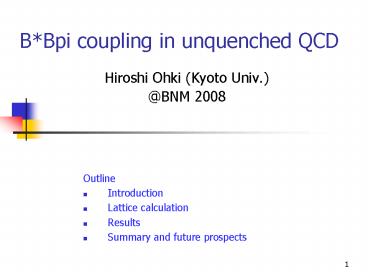BBpi coupling in unquenched QCD - PowerPoint PPT Presentation
Title:
BBpi coupling in unquenched QCD
Description:
Link smearing, Della Morte et al. hep-lat/0307021 ... Link smearing Della Morte et al. hep-lat/0307021. A new HQET action using HYP(APE) smeared links. ... – PowerPoint PPT presentation
Number of Views:61
Avg rating:3.0/5.0
Title: BBpi coupling in unquenched QCD
1
BBpi coupling in unquenched QCD
- Hiroshi Ohki (Kyoto Univ.)
- _at_BNM 2008
- Outline
- Introduction
- Lattice calculation
- Results
- Summary and future prospects
2
Introduction
- is very crucial parameter
- to test Standard Model.
- Exclusive decay can play a important role, but it
is consistent with unitarity and inclusive decay
due to large error dominated by theory.
We need more theoretical improvement for
exclusive semileptonic decay.
3
How to reduce the error?
- (1) Alternative approach
- Using soft pion theorem
parameter
- unquenched lattice results
- These parameters are very important for flavor
physics. - In Particular decay constant is already studied
widely. - BBpi coupling is determined almost 15 accuracy,
- crucial improvement is needed.
4
How to reduce the error?
(2) Further study dependencies of form
factor
- We could improve the precision if we can use the
experimental data for the whole range.
Our method Dispersive bound
Dispersive bound tells us the dependencies of
transfer momentum about form factors.
5
Plan of this work
- 1.
- High precision study of BBpi coupling
- in unquenched lattice calculation
- 2.
- Towards precise determination of Vub
- from dispersive bound
We focus on the BBpi coupling in this talk.
6
Lattice calculation
7
How to obtain BBpi coupling
- The BB pi coupling is defined by the matrix
element
Light-light axial verctor current
In the static limit
G.M.de Divitiis et al.JHEP 9810 (1998)010
Lattice simulation
8
Recent result
Figure from Abada et al. hep-lat/0310050
can be obtained by interpolating the
results in static limit and charm region.
Static results
Abada et al.
Becirevic et al.
- In full QCD we need significant improvement
- for precision, given limited configurations.
9
Our strategy
First high precision study of static BBpi
coupling in unquenched QCD using improved
techniques The first step towards the
determination of
Improved techniques
- Link smearing, Della Morte et al.
hep-lat/0307021 - All-to-all propagators with low mode averaging
-
J. Foley et al. hep-lat/0505023
10
Improved techniques
- Link smearing Della Morte et al.
hep-lat/0307021 - A new HQET action using HYP(APE) smeared links.
- Suppress the short distance fluctuation of the
gauge - field.
- All-to-all propagators with low mode averaging
- divide the light quark propagator into low and
high mode - Low mode low eigenmodes of the Dirac
Hamiltonian. - High mode using the standard random noise
methods.
J.Foley et al.hep-lat/0505023
T.A.DeGraand et al. hep-lat0202001 L.
Giusti et al.hep-lat/0402002
11
Simulation setup
- Actions
- Gauge Nf2 unquenched configurations by CP-PACS
- http//www.jldg.org/lqa/CPPACSconfig.html
- Light O(a)-improved Wilson
- Heavy Static quark with HYP1 link V(x,0)
- Computational resource
12
RESULTS
Simulation point
- Plots of 2,3-point functions
- Extraction of BBpi coupling
- Chiral extrapolation
13
Effective mass plots for 2, 3 point
B,B state Binding energy
We get good plateau. Ground state (B, B) is
successfully extracted.
14
Results for
3pt/2pt ratio
raw data
fit
Renormalization factor
2pt/3pt ratio to extract BBpi coupling works
very well.
15
Chiral extrapolation
We use three functions for fitting our numerical
data as follows
Fit by 3 points
Fit by 4 points
Mass dependence from chiral perturbation theory
H.Y.Cheng et al. Phys.Rev.D49(1994)5857
16
Chiral extrapolation
17
Error estimation
- Systematic Error estimate
- 1.chiral extrap.
- 2.perturbative.
- 3.disc.
- Preliminary result (beta1.95)
(2,3 order estimation)
18
Summary and future prospects
19
Summary
- The stat. error remains tiny for all quark
masses, giving 2 even in the chiral limit. - The error is dominated by systematic errors
- 6 from pert,
- 6 from chiral extrap,
- 6 from disc.
20
Reduce the errors
- Non perturbative matching of axial vector current
- ? feasible using PCAC relation
- Chiral extrapolation using unquenched configs.
with light sea quark masses. - (ex. JLQCD,PACS-CS)
- Discretization error can reduced by simulating of
finer lattices.
21
Future prospects
- Towards precise determination of Vub
Our method Dispersive bound
Input data
- Experiment data of partial branching
- fraction for B to pi l nu decay
- Lattice results of form factor
Ongoing project
- Including the value of form factor
- at B pole using BBpi coupling
Next step
22
Input data
Lattice simulation
Partial branching fraction spectrum for B to pi l
nu decay in 12 bins of
HPQCD collab. E. Gulez et al, Physical Review D
73,074502(2006)
BABAR Collab. B. Aubert et al.,
Phys.Rev.Lett.98,091801(2007),hep-ex/0612020
23
Preliminary results
2 inputs
Result of Vub distribution
Just for reference
24
Consideration
Our preliminary results
Lattice theory
Experiment
Dispersive Bound
error
- We made an exploratory study of Vub
determination with dispersive bounds and obtained
promising preliminary results using partial set
of inputs. - It is also consistent by recent result by Flynn,
Nieves 2007. - We made simplifications which could introduce
systematic errors. We should either discard such
simplification or study systematic errors, which
can make the error larger.
25
Finally
- To improve the accuracy
- We can use the full range of data.
- We can also use inputs from soft pion theorem
with BB pi coupling.
Moreover
Need improvements for experiment and theoretical
inputs.
26
- The End
Thank you































